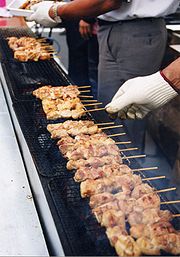
Yakitori
Encyclopedia

Japanese cuisine
Japanese cuisine has developed over the centuries as a result of many political and social changes throughout Japan. The cuisine eventually changed with the advent of the Medieval age which ushered in a shedding of elitism with the age of shogun rule...
type of skewer
Skewer
A skewer is a thin metal or wood stick used to hold pieces of food together. They are used while grilling or roasting meats, and in other culinary applications....
ed chicken
Chicken
The chicken is a domesticated fowl, a subspecies of the Red Junglefowl. As one of the most common and widespread domestic animals, and with a population of more than 24 billion in 2003, there are more chickens in the world than any other species of bird...
. The term Yakitori can also refer to skewered food in general. Kushiyaki (skewer grilled), is a formal term that encompasses both poultry and non-poultry items, skewered and grilled. Both Yakitori and Kushiyaki mean the same, so the terms are used interchangeably in Japanese society.
The average yakitori is made from several bite-sized pieces of chicken meat, or chicken offal
Offal
Offal , also called, especially in the United States, variety meats or organ meats, refers to the internal organs and entrails of a butchered animal. The word does not refer to a particular list of edible organs, which varies by culture and region, but includes most internal organs other than...
, skewered on a bamboo skewer and grilled, usually over charcoal
Charcoal
Charcoal is the dark grey residue consisting of carbon, and any remaining ash, obtained by removing water and other volatile constituents from animal and vegetation substances. Charcoal is usually produced by slow pyrolysis, the heating of wood or other substances in the absence of oxygen...
.
Diners ordering yakitori usually have a choice of having it cooked with salt
Salt
In chemistry, salts are ionic compounds that result from the neutralization reaction of an acid and a base. They are composed of cations and anions so that the product is electrically neutral...
(shio) or with tare sauce
Tare sauce
Tare is a general term in Japanese cuisine for dipping sauces often used in grilling as well as with sushi, nabemono and gyoza. The sauce is best described as sweetened, thickened soy sauce for grilling and flavored soy sauce with dashi, vinegar, etc., for nabemono and natto such as ponzu but...
, which is generally made up of mirin
Mirin
is an essential condiment used in Japanese cuisine, consisting of 40%–50% sugar. It is a kind of rice wine similar to sake, but with a lower alcohol content—14% instead of 20%. There are three general types. The first is hon mirin , which contains alcohol. The second is shio mirin, which contains...
, sake, soy sauce
Soy sauce
Soy sauce is a condiment produced by fermenting soybeans with Aspergillus oryzae or Aspergillus sojae molds, along with water and salt...
and sugar
Sugar
Sugar is a class of edible crystalline carbohydrates, mainly sucrose, lactose, and fructose, characterized by a sweet flavor.Sucrose in its refined form primarily comes from sugar cane and sugar beet...
. The sauce is applied to the skewered meat and is grilled until delicately cooked.
- hāto (ハート) or kokoro (こころ), chicken heart
- rebā (レバー), liver
- sunagimo (砂肝), or zuri (ずり) chicken gizzardGizzardThe gizzard, also referred to as the ventriculus, gastric mill, and gigerium, is an organ found in the digestive tract of some animals, including birds, reptiles, earthworms and some fish. This specialized stomach constructed of thick, muscular walls is used for grinding up food; often rocks are...
- tsukune (つくね), chicken meatballs
- (tori)kawa ((とり)かわ) chicken skin, grilled until crispy
- tebasaki (手羽先), chicken wing
- bonjiri (ぼんじり), chicken tail
- shiro (シロ), chicken small intestines
- nankotsu (なんこつ), chicken cartilage
- toriniku, all white meat on skewer
Common non-poultry dishes
- ikada (筏) (lit. raftRaftA raft is any flat structure for support or transportation over water. It is the most basic of boat design, characterized by the absence of a hull...
), Japanese scallion, with two skewers to prevent rotation - gyūtan (牛タン), beef tongue, sliced thinly
- atsuage tōfu (厚揚げとうふ), deep-fried tofuTofuis a food made by coagulating soy milk and then pressing the resulting curds into soft white blocks. It is part of East Asian and Southeast Asian cuisine such as Chinese, Japanese, Korean, Indonesian, Vietnamese, and others. There are many different varieties of tofu, including fresh tofu and tofu...
- enoki maki (エノキ巻き), enoki mushrooms wrapped in slices of pork
- pīman (ピーマン), green pepper
- asuparabēkon (アスパラベーコン), asparagusAsparagusAsparagus officinalis is a spring vegetable, a flowering perennialplant species in the genus Asparagus. It was once classified in the lily family, like its Allium cousins, onions and garlic, but the Liliaceae have been split and the onion-like plants are now in the family Amaryllidaceae and...
wrapped in bacon - butabara (豚ばら), pork bellyPork bellyPork belly is a boneless cut of fatty meat derived from the belly of a pig. Pork belly is popular in Asian cuisine, and forms a part of many traditional European dishes such as the Alsatian Choucroute garnie, the Swiss Berner Platte, and the German Schlachtplatte...
- ninniku (にんにく)garlicGarlicAllium sativum, commonly known as garlic, is a species in the onion genus, Allium. Its close relatives include the onion, shallot, leek, chive, and rakkyo. Dating back over 6,000 years, garlic is native to central Asia, and has long been a staple in the Mediterranean region, as well as a frequent...

